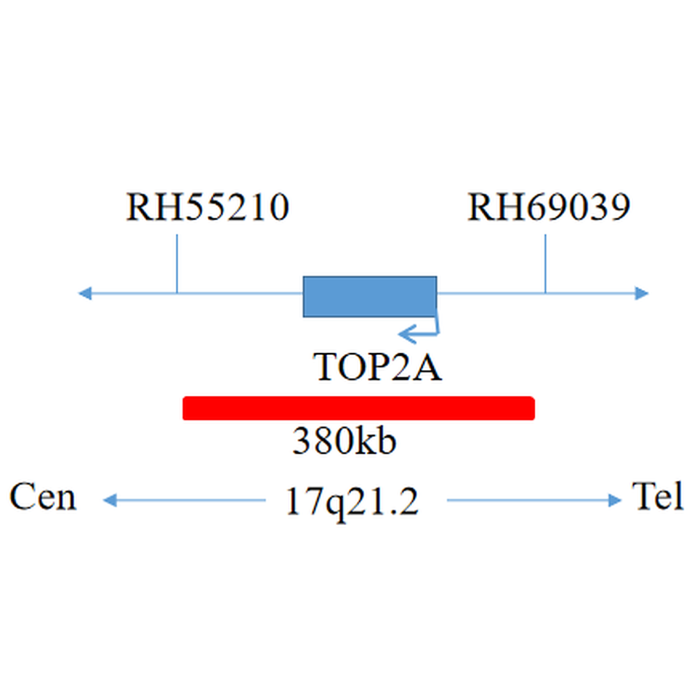TOP2A gene amplification detection probe (TOP2A)
TOP2A Gene Amplification Probe Detection Kit - 100µL/10 Tests
This gene encodes a DNA topoisomerase, an enzyme that controls and alters the topologic states of DNA during transcription. This nuclear enzyme is involved in processes such as chromosome condensation, chromatid separation, and the relief of torsional stress that occurs during DNA transcription and replication. It catalyzes the transient breaking and rejoining of two strands of duplex DNA which allows the strands to pass through one another, thus altering the topology of DNA. Two forms of this enzyme exist as likely products of a gene duplication event.
The gene encoding this form, alpha, is localized to chromosome 17 and the beta gene is localized to chromosome 3. The gene encoding this enzyme functions as the target for several anticancer agents and a variety of mutations in this gene have been associated with the development of drug resistance. Reduced activity of this enzyme may also play a role in ataxia-telangiectasia.
Product Main Components
The kit consists of a TOP2A orange-red probe and a CEP17 green probe hybridization solution
|
Component name |
Specifications |
Quantity |
Main components |
|
TOP2A/CEP17 dual color probe |
100μL/Tube |
1 |
TOP2A orange-red probe; CEP17 green probe |
Intended Use
This kit uses fluorescence in situ hybridization (FISH) to detect the TOP2A gene status in breast cancer tissues in vitro, and the test sample is a paraffin-embedded specimen of breast cancer surgery or biopsy tissue. This kit is only suitable for the detection of the TOP2A gene status and provides physicians with auxiliary information for diagnosis. Breast cancer is one of the most common malignant tumors in human beings and one of the main malignant tumors in women. In recent years, the incidence of breast cancer is on the rise. At present, invasive breast cancer has been regarded as a systemic disease, and its prognostic judgement and prognostic biomarkers have attracted much attention. Studies on breast cancer have shown that lymph node metastasis is more serious when TOP2A gene is expressed positively in breast cancer tissues; patients with abnormal TOP2A gene indicate shorter recurrence-free survival and worse prognosis in patients with TOP2A gene deletion.
Cytotoxic chemotherapeutics represented by anthracyclines are widely used in neoadjuvant chemotherapy and post-operative chemotherapy for breast cancer. They benefit some patients and cause great pain due to adverse cardiac reactions. However, there is no clear biological indicators to predict their efficacy. In the study of advanced breast cancer, it was found that TOP2A gene abnormality was significantly associated with protein expression and sensitivity of cancer cells to anthracyclines.
Compared with CMF regimen, CEF regimen (including anthracyclines) can reduce recurrence risk by 61% and mortality risk by 51% in patients with TOP2A abnormalities, while CEF regimen can only reduce recurrence risk by 6% and mortality risk by 10% in patients without TOP2A abnormalities. Therefore, the detection of TOP2A gene status has guiding significance for the treatment and prognosis of breast cancer. The kit has not been clinically validated in combination with the TOP2A gene-targeted therapeutic drug. Only the TOP2A gene detection performance was verified.
Detection Principle
This kit is based on fluorescence in situ hybridization, a nucleotide of the nucleic acid probe is labeled with fluorescein, and the detected target gene is homologously complementary to the nucleic acid probe used. After denaturation, annealing and renaturation, a hybrid of the target gene and the nucleic acid probe can be formed, and the gene to be detected is subjected to qualitative, quantitative or relative localization analysis under the microscope by a fluorescence detection system.
This kit uses the rhodamine fluorescein (RHO)-labeled orange-red probe (TOP2A probe) to detect the TOP2A gene, and the fluorescein isothiocyanate (FITC)-labeled green probe (CEP17 probe) for detection of chromosome 17. The two probes can be combined with the target detection site by in situ hybridization. The number of signals corresponding to the CEP17 probe reflects the number of chromosome 17 at the target site, and the number of signals of the TOP2A probe corresponds to the state of the target site TOP2A gene. By comparing the ratio of the orange-red signal to the green signal fluorescence number, the state of the TOP2A gene to be detected can be determined.


